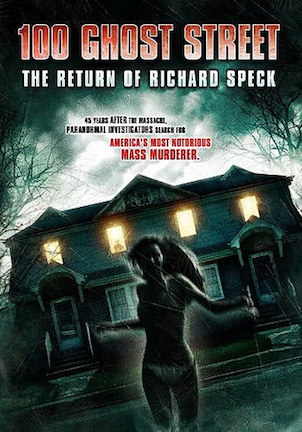Studio: The Asylum
Director: Martin Andersen
Writer: Nancy Leopardi
Producer: Nancy Leopardi
Stars: Jennifer Robyn Jacobs, Jim Shipley, Tony Besson, Jackie Moore, Hayley Derryberry, Adam LaFramboise, Mike Holley
Review Score:
Summary:
A television documentary crew investigates the haunted site where Richard Speck murdered a group of student nurses in 1966.
Review:
Hand it to The Asylum for not excluding themselves from the crosshairs of their blatant ripoff sniper scope. When the well runs dry of Hollywood blockbusters to inspire knockoff productions, The Asylum turns to their own catalog of horror schlock for recycled ideas. Nipping at the coattails of The Asylum’s own “8213: Gacy House” comes “100 Ghost Street: The Return of Richard Speck,” another “found footage” paranormal investigation chiller using a real life serial killer for its diving board.
The major difference between the two is that “100 Ghost Street” is so strict about following a vanilla formula that it does not have time to offer the same peculiar personalities “8213: Gacy House” had as a diversion. “100 Ghost House” also has a far less fearsome criminal motivating events.
With an unintentional wink beyond the fourth wall, one of the documentary crewmembers investigating the building on hand makes an observation that coincidentally sums up the movie’s chief hurdle. “The real problem is Richard Speck.” Agreed.
As tasteless as it is to compare serial killer body counts like macabre performance statistics, there is a point made by weighing Speck’s evil against that of Jeffrey Dahmer, Richard Ramirez, or John Wayne Gacy, Jr. Those latter three men were spree killers who moved undetected for long periods and gripped their neighborhoods with legitimate panic and ongoing terror.
Speck’s murders, on the other hand, were a one-night affair confined to a comparatively small and select faction. Richard Speck was just a pathetic degenerate. Which is not to elevate the status of the other names, but their crimes created a psychological effect that carries an impact into the 21st century. The box cover can erroneously label Speck as “America’s most notorious mass murder,” yet Speck disappeared from the public consciousness for good reason. Frankly, his presence does not have anywhere near the same inherent fear factor as Dahmer, Ramirez, or Gacy.
In July of 1966, Richard Speck broke into a townhouse in the Jeffery Manor neighborhood of Chicago and brutally murdered eight student nurses. This is an easy number to get straight, yet “100 Ghost Street” continually insists that Speck murdered seven young women. In fact, when one character mentions eight deaths, another incorrectly corrects the figure to seven once again. It is never promising when a screenplay forgoes the four seconds it takes for a cursory Wikipedia fact check, but that is just the beginning of the film’s half-hearted attempt to deliver anything resembling an effort.
The converted townhouse that served as the student nurses’ dormitory is also fudged into a cavernous building so expansive that the documentary crewmembers become regularly lost and separated with ease. It makes little sense that Speck's specter would emit guttural clicking sounds like the Predator. It makes less sense that he would be tied to a crime scene he barely spent a few hours in. It makes no sense at all that his ghost would use the location as a makeshift aviary littered with birdcages and an incubator for raising live pigeons.
Richard Speck reportedly acquired the nickname “birdman” while in prison after adopting a pair of sparrows that flew into his cell. “100 Ghost Street” turns that forgettable factoid into a major development point that is just one more “huh?” moment in a movie already filled to bursting with them.
The scariest thing in the movie is this guy's hairstyle.
Nine is a minimum of two or three too many characters to keep track of in a quickie like this. Incidentally, nine is how many women were in the dormitory on the night of the 1966 murders (eight victims and one survivor). Had “100 Ghost Street” gotten its facts straight, the bloated fictional crew list could have been forgiven for cleverly mirroring the original crimes.
Instead, “100 Ghost Street” loads up on bodies for Speck’s ghost to eviscerate before anyone in the audience has a chance to learn their names. The only personalities that can even be described with adjectives are the unlikable producer and the pretty-but-amateur show host unable to deliver an on camera line without fumbling a word.
Speaking of words, someone padded the script by photocopying the middle pages and reusing them liberally. When crewmember Sarah goes missing, the other team members begin a search that involves calling the girl’s name a total of 31 times. Six of those come after they have already found her.
Scares are of the crash, boom, bang variety. A bookcase tips to the floor. A fire extinguisher falls from the wall. A gurgle spouts from standing water. A yawn comes from the viewer trying vainly to remain interested.
In whatever Bizarro world where someone is forced to choose one “found footage” Asylum film based on a dead serial killer under threat of a firing squad, the correct decision is to light a cigarette and wear a blindfold. But if one absolutely has to, “8213: Gacy House” is the lesser of two evils, simply for its sauciness and humorously bad taste in depicting unbelievable séances and phantom sexual assaults. “100 Ghost Street” is a further step backward with no historical accuracy, no fun factor, and nothing original to set it apart from the rest of the flotsam clogging the sub-genre.
NOTE: “100 Ghost Street” was released in Europe as “Paranormal Entity 4: The Awakening.”
Review Score: 30







No matter where a personal opinion lands, you still have to tip your cap to an imaginative vision that stays true to pursuing its own path.